Product Categories
SHOP BY ARTIST
NEWSLETTER
Allison Lee
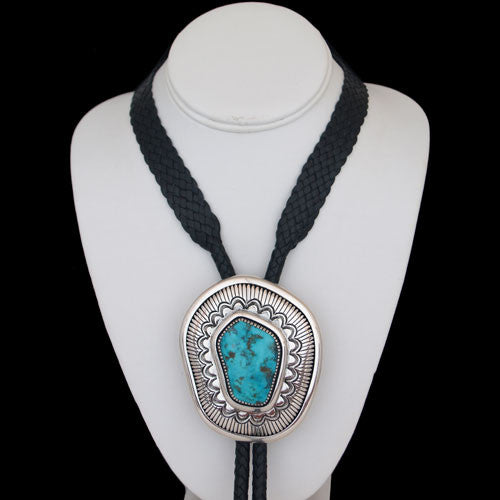
Navajo High Grade Morenci Turquoise Bolo Tie - Allison Lee (#196)
$3,750.00
Artist: Allison Lee
Bolo: 2 3/4" x 3 1/4"
Strap: 50"
Allison Snowhawk Lee has taken a wonderful piece of gem-grade Morenci turquoise and mounted it in one of his classically beautiful hand-fabricated, sterling silver settings. Allison is the most refined finish artist we know, and one of the best all around silversmiths. Who better to set a remarkable stone than a remarkable artist? Beauty, rarity and durability are the three attributes that distinguish a quality, collectible piece of art. All three are definitely present with this amazing bolo tie.
Morenci Turquoise
Morenci Turquoise; Arizona Mine, Morenci, Clifton-Morenci District, Shannon Mountains, Greenlee County, Arizona, USA. An open pit copper mine located in the N1⁄2 Section 16, T4S, R29E (Clifton 15 minute topographic map), owned by Phelps Dodge Corp. Map Reference: 33°5'26"N, 109°21'58"W.
Morenci turquoise was mined in southeastern Arizona until approximately 1990. It is located very near the New Mexico border, and ranges in color from classic high electric blue to light azure. Prehistoric Indians who valued the stone for its deep blue color were the first to discover the deposit. These people adorned themselves with rough-hewn beads and carved talisman made from the mineral
Morenci is often associated with an unusual black matrix of irregular iron pyrite, which looks metallic when polished. Although they are rare, stones with unusual birds-eye patterns, red matrix and an occasional layer of silver have also been found. The Morenci name is derived from the large open pit copper mine owned and operated by the Phelps Dodge Corporation. Early examples of this striking turquoise were of the "lunch box" variety, meaning workers and miners carried them out of the mine.
Morenci is well known; it was one of the first types of American turquoise to find its way to the market and is always difficult to obtain because the mine was depleted so long ago. It is believed that the best Morenci ever produced was discovered in the late 1960's to early 70's. During this time period, the mine produced a high, electric blue variety with iron pyrite inclusions. Since Morenci is no longer being mined, and because of its striking color and unusual matrix combinations, high grade natural Morenci is a valuable, highly collectible mineral.
USGS; Arizona.--In Arizona turquoise ranks first in terms of value of production and is also the best known of its gem materials. Nearly all-important deposits of turquoise are located near copper occurrences or in copper deposits in arid desert regions of the world. Thus, the world famous turquoise deposits associated with certain of the large Arizona copper deposits are to be expected.
Turquoise is, or has been, mined from a number of these copper mines as a byproduct, usually by outside contractors. The financial and operating terms of the collecting contracts vary from mine to mine. Some of the operations are little more than the efforts of individual commercial collectors; some are essentially full-scale mining operations that are simultaneous with, but separate from, the regular mining operations; and still others operate on an on-call basis as turquoise is uncovered by the regular copper mining operation. Regardless of the size or sophistication of the initial mining or recovery operation, the actual turquoise is recovered by careful extraction using hand method.
About the artist:

Allison Lee - Navajo Silversmith:
Speaking of the silver and gold jewelry he hand crafts, Allison Lee's captivating voice is sincere when he says, "One time my uncle told me that everything we build comes from the earth, like the silver that comes from the earth, or the turquoise that comes from the earth. That is a lot of energy. You put it together and you put your heart and mind into a piece. Then sometimes a certain piece of jewelry- I believe- it is made for a certain person. I usually have a ring, or something, that stays with me for about two or three years, until the right person comes along. And then that person buys that piece. I believe that every piece of jewelry that I make is made for somebody out there- it's made for somebody special. Whoever might be having problems, or something like that. In essence, that energy helps that person get help, by wearing pieces that we make. That is the way I look at it.
Related legends:
Silversmith Work
When and how the Navajo acquired the art of working metals is unknown but there are reasons for supposing that it was introduced among them, or at least more developed and improved upon by them, since the time they have occupied their present country?
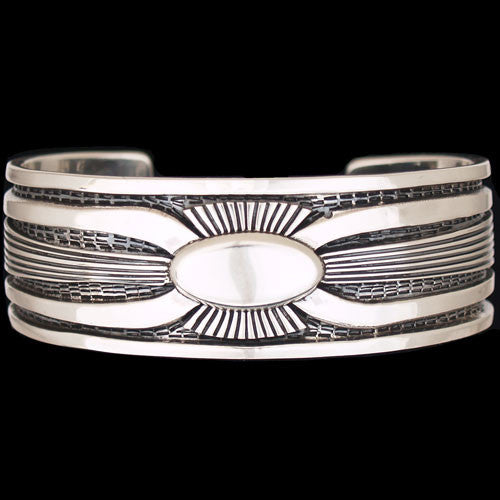
Navajo Ketoh Design Sterling Silver Bracelet - Allison Lee (#181)
$1,150.00
Artist: Allison Lee
Total Inner Circumference including opening: 7 1/2"
Opening: 1 1/4"
About the artist:

Allison Lee - Navajo Silversmith:
Speaking of the silver and gold jewelry he hand crafts, Allison Lee's captivating voice is sincere when he says, "One time my uncle told me that everything we build comes from the earth, like the silver that comes from the earth, or the turquoise that comes from the earth. That is a lot of energy. You put it together and you put your heart and mind into a piece. Then sometimes a certain piece of jewelry- I believe- it is made for a certain person. I usually have a ring, or something, that stays with me for about two or three years, until the right person comes along. And then that person buys that piece. I believe that every piece of jewelry that I make is made for somebody out there- it's made for somebody special. Whoever might be having problems, or something like that. In essence, that energy helps that person get help, by wearing pieces that we make. That is the way I look at it.
Related legends:
Silversmith Work
When and how the Navajo acquired the art of working metals is unknown but there are reasons for supposing that it was introduced among them, or at least more developed and improved upon by them, since the time they have occupied their present country?
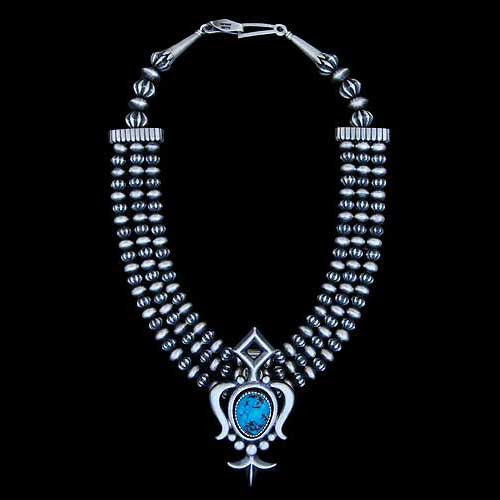
Navajo Kingman Turquoise and Sterling Silver Triple Bead Strand Necklace - Allison Lee (#124)
$3,000.00
Artist: Allison Lee
Navajo Jewelry
Necklace: 18" long
Pendant: 3" tall x 1 1/2" wide
Stone: 7/8" tall x 5/8" wide
We offer a 100% satisfaction guarantee on every purchase.
Kingman Turquoise
Kingman Turquoise comes from a large open-pit copper mine in the Mineral Park Mining District, northwest of Kingman, Arizona and was one of the largest turquoise mines in this country. The area lies in high desert country at an elevation of 3,345 feet and is surrounded by three mountain ranges. The mining district around Kingman, Arizona has always been a large producer of turquoise, at one time the world's largest. First mined by Indians, this area was home to the most extensive prehistoric workings found in Arizona.
The modern production of turquoise dates back to the early 1880’s when James Haas rediscovered these ancient Kingman area mines. Much of the turquoise occurred as seams, masses and veins. The color of natural Kingman turquoise can range from light blue to very dark blue and sometimes tints of green. The matrix is from white, light brown to black and frequently flecked with pyrite and times quartz. The mine became famous for its rounded, bright blue nuggets with black matrix. Few turquoise mines produced nuggets, especially of this quality. In its high-grade form it has always been considered among the top quality American turquoise. With so many thousands of pounds of good quality turquoise produced in the Kingman area over the last one hundred years it is hard to believe that today very little high-grade Kingman turquoise is available.
Other names for Kingman turquoise: Ithaca Peak, The Wall, Tiffany, Courtland, Az., Gleeson
Most desirable: Deep Blue with molybdenum pyrite; Real blue with pyrite; Bird's eye; Water Web; Nuggets
About the artist:

Allison Lee - Navajo Silversmith:
Speaking of the silver and gold jewelry he hand crafts, Allison Lee's captivating voice is sincere when he says, "One time my uncle told me that everything we build comes from the earth, like the silver that comes from the earth, or the turquoise that comes from the earth. That is a lot of energy. You put it together and you put your heart and mind into a piece. Then sometimes a certain piece of jewelry- I believe- it is made for a certain person. I usually have a ring, or something, that stays with me for about two or three years, until the right person comes along. And then that person buys that piece. I believe that every piece of jewelry that I make is made for somebody out there- it's made for somebody special. Whoever might be having problems, or something like that. In essence, that energy helps that person get help, by wearing pieces that we make. That is the way I look at it.
Related legends:
Silversmith Work
When and how the Navajo acquired the art of working metals is unknown but there are reasons for supposing that it was introduced among them, or at least more developed and improved upon by them, since the time they have occupied their present country?
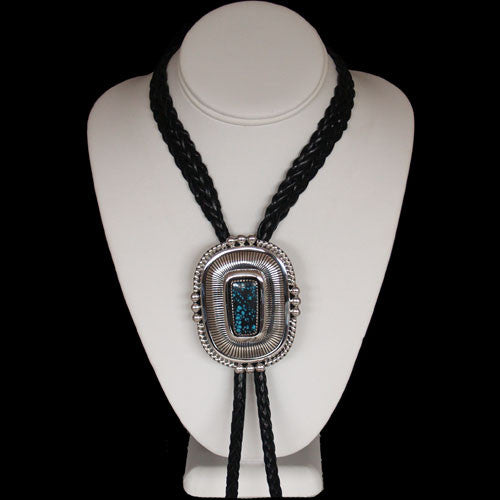
Navajo Lone Mountain Turquoise Sterling Silver Bolo Tie - Allison Lee (#175)
$2,500.00
Artist: Allison Lee
Navajo Jewelry
Bolo: 2 1/2" x 3"
Strap: 43"
Man, if you want a bolo tie to replace your current silk ones, this is it! With a spectacular, and I mean spectacular, piece of Lone Mountain turquoise set in an Allison Lee mounting, you will receive raves when you wear it.
We offer a 100% satisfaction guarantee on every purchase.
Lone Mountain Turquoise
The Lone Mountain turquoise mine is located near Tonapah, in Esmeralda County, Nevada. Since it is known for producing a high percentage of gem-grade turquoise, it is often referred to as a "sweet heart" mine. Originally established in 1920 by Lee Hand, the claim was initially called the Blue Jay Mining Lode. Later, after noting that so many other mines had been named Blue Jay, Hand changed its name to Lone Mountain.
In 1927, at a depth of about 40 feet, Bert Kopenhaver, who had leased the mine from Hand, found the beautiful spider web turquoise that made Lone Mountain one of the top mines in the Southwest. Although it has change hands several times over the years, the mine still produces a small amount of quality material. The Lone Mountain claim is currently owned by Gene Wadell and operated by Chris Lott.
Also known for exquisite, deep blue stones, the mine has historically produced some of the highest quality spider web turquoise in the world. "Fossil turquoise" has also been found in the mine. This was formed when ancient plants and seashells dissolved, leaving only cavities that were later filled with turquoise deposits. Additionally, turquoise nuggets in moss agate have been found. Because of its extraordinary hard nature, Lone Mountain turquoise has the ability to retain its rich color and is therefore a valuable addition to any jewelry collection.
About the artist:

Allison Lee - Navajo Silversmith:
Speaking of the silver and gold jewelry he hand crafts, Allison Lee's captivating voice is sincere when he says, "One time my uncle told me that everything we build comes from the earth, like the silver that comes from the earth, or the turquoise that comes from the earth. That is a lot of energy. You put it together and you put your heart and mind into a piece. Then sometimes a certain piece of jewelry- I believe- it is made for a certain person. I usually have a ring, or something, that stays with me for about two or three years, until the right person comes along. And then that person buys that piece. I believe that every piece of jewelry that I make is made for somebody out there- it's made for somebody special. Whoever might be having problems, or something like that. In essence, that energy helps that person get help, by wearing pieces that we make. That is the way I look at it.
Related legends:
Silversmith Work
When and how the Navajo acquired the art of working metals is unknown but there are reasons for supposing that it was introduced among them, or at least more developed and improved upon by them, since the time they have occupied their present country?
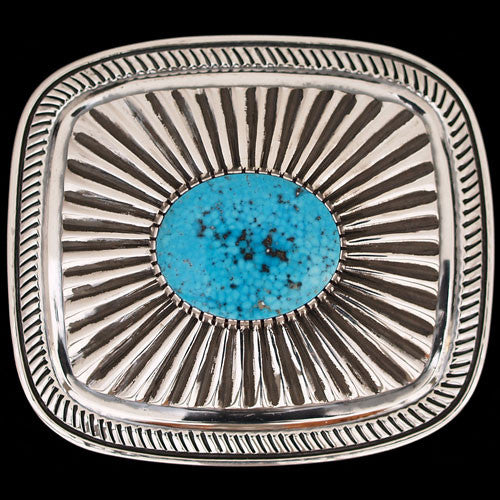
Navajo Morenci Turquoise Buckle - Allison Lee (#169)
$1,485.00
Artist: Allison Lee
Navajo Jewelry
2 1/2" x 2 1/4"
Allison Lee is surely one of the finest contemporary Navajo silversmiths working in the Southwest, likely the country. This immaculately conceived and exquisitely executed buckle shows off Allison’s skill. Wear this one dressed up or dressed down, just wear it. You will never be sorry you did.
We offer a 100% satisfaction guarantee on every purchase.
Morenci Turquoise
Morenci Turquoise; Arizona Mine, Morenci, Clifton-Morenci District, Shannon Mountains, Greenlee County, Arizona, USA. An open pit copper mine located in the N1⁄2 Section 16, T4S, R29E (Clifton 15 minute topographic map), owned by Phelps Dodge Corp. Map Reference: 33°5'26"N, 109°21'58"W.
Morenci turquoise was mined in southeastern Arizona until approximately 1990. It is located very near the New Mexico border, and ranges in color from classic high electric blue to light azure. Prehistoric Indians who valued the stone for its deep blue color were the first to discover the deposit. These people adorned themselves with rough-hewn beads and carved talisman made from the mineral
Morenci is often associated with an unusual black matrix of irregular iron pyrite, which looks metallic when polished. Although they are rare, stones with unusual birds-eye patterns, red matrix and an occasional layer of silver have also been found. The Morenci name is derived from the large open pit copper mine owned and operated by the Phelps Dodge Corporation. Early examples of this striking turquoise were of the "lunch box" variety, meaning workers and miners carried them out of the mine.
Morenci is well known; it was one of the first types of American turquoise to find its way to the market and is always difficult to obtain because the mine was depleted so long ago. It is believed that the best Morenci ever produced was discovered in the late 1960's to early 70's. During this time period, the mine produced a high, electric blue variety with iron pyrite inclusions. Since Morenci is no longer being mined, and because of its striking color and unusual matrix combinations, high grade natural Morenci is a valuable, highly collectible mineral.
USGS; Arizona.--In Arizona turquoise ranks first in terms of value of production and is also the best known of its gem materials. Nearly all-important deposits of turquoise are located near copper occurrences or in copper deposits in arid desert regions of the world. Thus, the world famous turquoise deposits associated with certain of the large Arizona copper deposits are to be expected.
Turquoise is, or has been, mined from a number of these copper mines as a byproduct, usually by outside contractors. The financial and operating terms of the collecting contracts vary from mine to mine. Some of the operations are little more than the efforts of individual commercial collectors; some are essentially full-scale mining operations that are simultaneous with, but separate from, the regular mining operations; and still others operate on an on-call basis as turquoise is uncovered by the regular copper mining operation. Regardless of the size or sophistication of the initial mining or recovery operation, the actual turquoise is recovered by careful extraction using hand method.
About the artist:

Allison Lee - Navajo Silversmith:
Speaking of the silver and gold jewelry he hand crafts, Allison Lee's captivating voice is sincere when he says, "One time my uncle told me that everything we build comes from the earth, like the silver that comes from the earth, or the turquoise that comes from the earth. That is a lot of energy. You put it together and you put your heart and mind into a piece. Then sometimes a certain piece of jewelry- I believe- it is made for a certain person. I usually have a ring, or something, that stays with me for about two or three years, until the right person comes along. And then that person buys that piece. I believe that every piece of jewelry that I make is made for somebody out there- it's made for somebody special. Whoever might be having problems, or something like that. In essence, that energy helps that person get help, by wearing pieces that we make. That is the way I look at it.
Related legends:
Precious Stones
Turquoise; Precious stones have symbolic implications. For example, turquoise if a "collective term for all the precious stones, wealth, or mixed offerings. Good fortune is attributed to this stone." Both white shell and turquoise are emphasized in Kinaalda? More about this legend
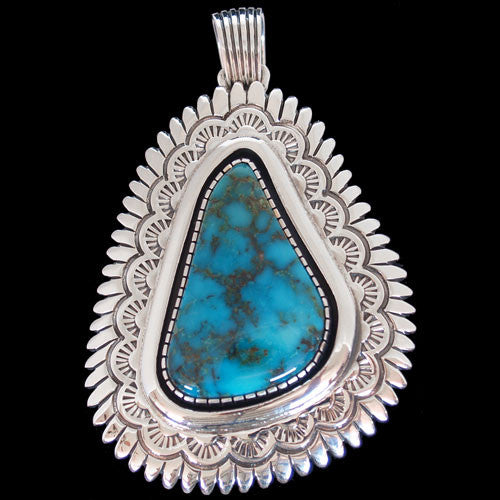
Navajo Natural Blue Gem 38cts Turquoise Pendant - Allison Lee (#194)
$2,775.00
Artist: Allison Lee
2" x 3 1/8"
Stone: 7/8" x 1 1/2"
It has taken Allison Snowhawk Lee over 40 years to achieve the level of sophistication he now has in his art. His attention to detail is, in a word, amazing, and his finish work is so crisp and squeaky clean it is hard to believe. The stamp and file work on this pendent must be examined under magnification to really appreciate it. The turquoise is super high-grade natural from the Blue Gem mine in Nevada. It is incredible. This pendent is "over the top."
Blue Gem Turquoise
Blue Gem turquoise occurs in argillized quartz monzonite cut by two limonite-stained sheer zones, one trending N 35 o W and dipping 75 o NE, the other trending N, 25 o E and dipping 55 o NW. An extensive breccia zone about 10 feet wide is developed between the two bounding sheers. Exceptionally good quality turquoise forms veins up to three-quarters of an inch thick along the shears. Pyrite-bearing quartz veins are closely associated with the turquoise.
The Blue Gem mine was at one time located deep underground, accessed by tunnels as deep as 800 feet. This is of interest because the Blue Gem Mine and the Bisbee Mine in Arizona are the only two mines (of which we are aware) that turquoise was found that deep in the earth. The Blue Gem mine was once developed in extensive underground workings and open stoops. An audit several hundred feet long on the main structure connected to numerous shorter tunnels and several open stoops. Directly above the main audit was a glory hole some 100 feet long.
Duke Goff first noted the Blue Gem deposit in 1934. It was subsequently leased from the Copper Canyon Mining Co. by the American Gem Co. of San Gabriel, CA., owned by Doc Wilson and his sons, Del and William. The company operated the property until 1941 when the outbreak of the war caused a shortage of experienced miners. Both Del and William Wilson were called into the Army for the duration of the war, and this compelled the closing of the mine. Consequently, the lease was allowed to lapse and work was abandoned. In 1950 Lee Hand and Alvin Layton of Battle Mountain leased the mine.
Production of turquoise at the Blue Gem lease in the early days of the operation was enormous. Although there is no exact information, it is reported that the output amounted to nearly
$1 million in rough turquoise. The mine is still active, although Duval Corp is currently in the center of a major copper deposit developing it.
Pyrite in Blue Gem is unusual to see but not unheard of. Very little large material ever came out of Blue Gem, the majority found was small 1-mm "bleeder" veins and tiny nuggets which was perfect for Zuni inlay and fine needlepoint, petit-point and snake-eyes jewelry. Blue Gem turquoise was very popular in the late 1930's and 40's and was commonly used in the Fred Harvey "tourist jewelry" that is so collectable today. Blue Gem turquoise is extremely hard and stands up well to the test of time.
Blue Gem turquoise is a rare, valuable and historic American treasure. Quality Blue Gem Turquoise has been gifted with a wide range and variety of color. Because Blue Gem turquoise is very hard, a high polish is associated with this stone, and unlike most turquoise, won't easily change color. This turquoise has a unique character and many different looks all of which are striking, full of wonder and pleasing to the eye.
Production of the mine started about 1934 and continued into the 1970's. Blue Gem Turquoise is still some of the finest turquoise ever found, and unlike most turquoise mines, (in which the majority mined is chalky and only usable if stabilized) most of the turquoise found there was of gem-quality. Today the Blue Gem mine is not viable; it sits in the middle of a huge mining operation. The emphasis is on precious metals and the extraction of turquoise is considered more of a hindrance in the mining process rather than an asset. Even the ever-popular "Dump Diving" for turquoise through the overburden is not tolerated due to the very real danger of becoming buried in a slide. Insurance factors, equipment hazards, high explosives and safety issues along with a lack of interest from the mining company keep Blue Gem turquoise unavailable to the world, at least for now.
About the artist:

Allison Lee - Navajo Silversmith:
Speaking of the silver and gold jewelry he hand crafts, Allison Lee's captivating voice is sincere when he says, "One time my uncle told me that everything we build comes from the earth, like the silver that comes from the earth, or the turquoise that comes from the earth. That is a lot of energy. You put it together and you put your heart and mind into a piece. Then sometimes a certain piece of jewelry- I believe- it is made for a certain person. I usually have a ring, or something, that stays with me for about two or three years, until the right person comes along. And then that person buys that piece. I believe that every piece of jewelry that I make is made for somebody out there- it's made for somebody special. Whoever might be having problems, or something like that. In essence, that energy helps that person get help, by wearing pieces that we make. That is the way I look at it.
Related legends:
Silversmith Work
When and how the Navajo acquired the art of working metals is unknown but there are reasons for supposing that it was introduced among them, or at least more developed and improved upon by them, since the time they have occupied their present country?
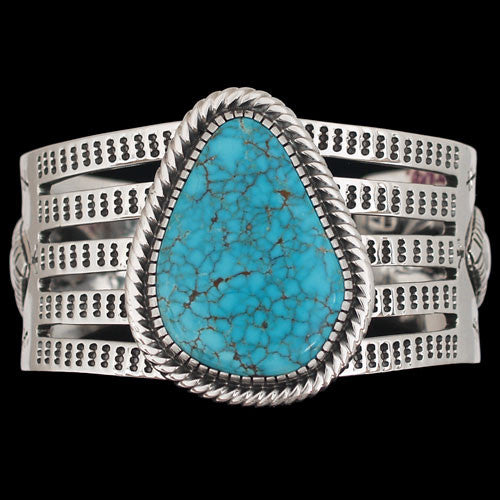
Navajo Natural Gem Grade Morenci Water-web Turquoise Bracelet - Allison Lee (#185)
$2,350.00
Artist: Allison Lee
Total inner circumference including opening: 6 1/2"
Opening: 1 1/4"
Super high-grade, natural, water-web Morenci turquoise is the centerpiece of this remarkable cuff bracelet by Navajo artist Allison Snowhawk Lee. Made in the traditional style, the bracelet is heavy, well made and unusually attractive. Allison is one of the most refined silversmiths of the modern age; his finish detail is enviable and his choice of turquoise top-drawer. When looking for collector-quality jewelry from a Native American artist, look no further than Allison Lee.
Morenci Turquoise
Morenci Turquoise; Arizona Mine, Morenci, Clifton-Morenci District, Shannon Mountains, Greenlee County, Arizona, USA. An open pit copper mine located in the N1⁄2 Section 16, T4S, R29E (Clifton 15 minute topographic map), owned by Phelps Dodge Corp. Map Reference: 33°5'26"N, 109°21'58"W.
Morenci turquoise was mined in southeastern Arizona until approximately 1990. It is located very near the New Mexico border, and ranges in color from classic high electric blue to light azure. Prehistoric Indians who valued the stone for its deep blue color were the first to discover the deposit. These people adorned themselves with rough-hewn beads and carved talisman made from the mineral
Morenci is often associated with an unusual black matrix of irregular iron pyrite, which looks metallic when polished. Although they are rare, stones with unusual birds-eye patterns, red matrix and an occasional layer of silver have also been found. The Morenci name is derived from the large open pit copper mine owned and operated by the Phelps Dodge Corporation. Early examples of this striking turquoise were of the "lunch box" variety, meaning workers and miners carried them out of the mine.
Morenci is well known; it was one of the first types of American turquoise to find its way to the market and is always difficult to obtain because the mine was depleted so long ago. It is believed that the best Morenci ever produced was discovered in the late 1960's to early 70's. During this time period, the mine produced a high, electric blue variety with iron pyrite inclusions. Since Morenci is no longer being mined, and because of its striking color and unusual matrix combinations, high grade natural Morenci is a valuable, highly collectible mineral.
USGS; Arizona.--In Arizona turquoise ranks first in terms of value of production and is also the best known of its gem materials. Nearly all-important deposits of turquoise are located near copper occurrences or in copper deposits in arid desert regions of the world. Thus, the world famous turquoise deposits associated with certain of the large Arizona copper deposits are to be expected.
Turquoise is, or has been, mined from a number of these copper mines as a byproduct, usually by outside contractors. The financial and operating terms of the collecting contracts vary from mine to mine. Some of the operations are little more than the efforts of individual commercial collectors; some are essentially full-scale mining operations that are simultaneous with, but separate from, the regular mining operations; and still others operate on an on-call basis as turquoise is uncovered by the regular copper mining operation. Regardless of the size or sophistication of the initial mining or recovery operation, the actual turquoise is recovered by careful extraction using hand method.
About the artist:

Allison Lee - Navajo Silversmith:
Speaking of the silver and gold jewelry he hand crafts, Allison Lee's captivating voice is sincere when he says, "One time my uncle told me that everything we build comes from the earth, like the silver that comes from the earth, or the turquoise that comes from the earth. That is a lot of energy. You put it together and you put your heart and mind into a piece. Then sometimes a certain piece of jewelry- I believe- it is made for a certain person. I usually have a ring, or something, that stays with me for about two or three years, until the right person comes along. And then that person buys that piece. I believe that every piece of jewelry that I make is made for somebody out there- it's made for somebody special. Whoever might be having problems, or something like that. In essence, that energy helps that person get help, by wearing pieces that we make. That is the way I look at it.
Related legends:
Silversmith Work
When and how the Navajo acquired the art of working metals is unknown but there are reasons for supposing that it was introduced among them, or at least more developed and improved upon by them, since the time they have occupied their present country?
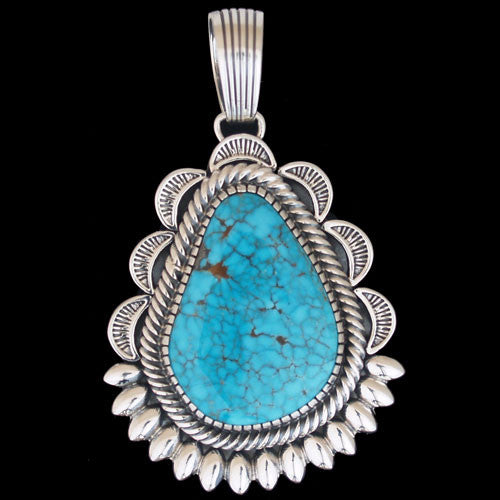
Navajo Natural Gem Grade Morenci Water-web Turquoise Pendant - Allison Lee (#184)
$1,475.00
Artist: Allison Lee
1 3/4" x 2 3/4"
Because Allison Snowhawk Lee is such a fine craftsman, he is often given access to the most precious stones. Super high-grade natural water-web Morenci turquoise is an example of such specimens, and when presented in a hand-fabricated setting by this master silversmith it becomes even dearer. Compare this stone and its setting to anything you have ever seen and you will have a benchmark for quality. Enough said.
Morenci Turquoise
Morenci Turquoise; Arizona Mine, Morenci, Clifton-Morenci District, Shannon Mountains, Greenlee County, Arizona, USA. An open pit copper mine located in the N1⁄2 Section 16, T4S, R29E (Clifton 15 minute topographic map), owned by Phelps Dodge Corp. Map Reference: 33°5'26"N, 109°21'58"W.
Morenci turquoise was mined in southeastern Arizona until approximately 1990. It is located very near the New Mexico border, and ranges in color from classic high electric blue to light azure. Prehistoric Indians who valued the stone for its deep blue color were the first to discover the deposit. These people adorned themselves with rough-hewn beads and carved talisman made from the mineral
Morenci is often associated with an unusual black matrix of irregular iron pyrite, which looks metallic when polished. Although they are rare, stones with unusual birds-eye patterns, red matrix and an occasional layer of silver have also been found. The Morenci name is derived from the large open pit copper mine owned and operated by the Phelps Dodge Corporation. Early examples of this striking turquoise were of the "lunch box" variety, meaning workers and miners carried them out of the mine.
Morenci is well known; it was one of the first types of American turquoise to find its way to the market and is always difficult to obtain because the mine was depleted so long ago. It is believed that the best Morenci ever produced was discovered in the late 1960's to early 70's. During this time period, the mine produced a high, electric blue variety with iron pyrite inclusions. Since Morenci is no longer being mined, and because of its striking color and unusual matrix combinations, high grade natural Morenci is a valuable, highly collectible mineral.
USGS; Arizona.--In Arizona turquoise ranks first in terms of value of production and is also the best known of its gem materials. Nearly all-important deposits of turquoise are located near copper occurrences or in copper deposits in arid desert regions of the world. Thus, the world famous turquoise deposits associated with certain of the large Arizona copper deposits are to be expected.
Turquoise is, or has been, mined from a number of these copper mines as a byproduct, usually by outside contractors. The financial and operating terms of the collecting contracts vary from mine to mine. Some of the operations are little more than the efforts of individual commercial collectors; some are essentially full-scale mining operations that are simultaneous with, but separate from, the regular mining operations; and still others operate on an on-call basis as turquoise is uncovered by the regular copper mining operation. Regardless of the size or sophistication of the initial mining or recovery operation, the actual turquoise is recovered by careful extraction using hand method.
About the artist:

Allison Lee - Navajo Silversmith:
Speaking of the silver and gold jewelry he hand crafts, Allison Lee's captivating voice is sincere when he says, "One time my uncle told me that everything we build comes from the earth, like the silver that comes from the earth, or the turquoise that comes from the earth. That is a lot of energy. You put it together and you put your heart and mind into a piece. Then sometimes a certain piece of jewelry- I believe- it is made for a certain person. I usually have a ring, or something, that stays with me for about two or three years, until the right person comes along. And then that person buys that piece. I believe that every piece of jewelry that I make is made for somebody out there- it's made for somebody special. Whoever might be having problems, or something like that. In essence, that energy helps that person get help, by wearing pieces that we make. That is the way I look at it.
Related legends:
Silversmith Work
When and how the Navajo acquired the art of working metals is unknown but there are reasons for supposing that it was introduced among them, or at least more developed and improved upon by them, since the time they have occupied their present country?
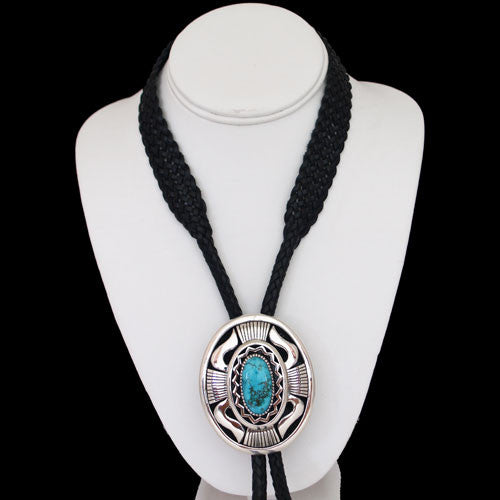
Navajo Natural High Gem Grade Blue Gem Turquoise Bolo Tie - Allison Lee (#191)
$3,200.00
Artist: Allison Lee
Bolo: 2 3/8" x 2 7/8"
Stone: .58" x 1.22"
Strap: 44"
Allison Lee is surely one of the most talented silversmiths we have ever run into. When you connect him with turquoise from Barry’s private reserve; well, the result is, as you see, SPECTACULAR. Sorry for shouting, but this oval piece of high-grade Blue Gem fits right into Allison’s carved and stamped Ketoh design. It is a rare individual who can fabricate bolo ties of this quality. Both Allison and his jewelry are extraordinary.
Blue Gem Turquoise
Blue Gem turquoise occurs in argillized quartz monzonite cut by two limonite-stained sheer zones, one trending N 35 o W and dipping 75 o NE, the other trending N, 25 o E and dipping 55 o NW. An extensive breccia zone about 10 feet wide is developed between the two bounding sheers. Exceptionally good quality turquoise forms veins up to three-quarters of an inch thick along the shears. Pyrite-bearing quartz veins are closely associated with the turquoise.
The Blue Gem mine was at one time located deep underground, accessed by tunnels as deep as 800 feet. This is of interest because the Blue Gem Mine and the Bisbee Mine in Arizona are the only two mines (of which we are aware) that turquoise was found that deep in the earth. The Blue Gem mine was once developed in extensive underground workings and open stoops. An audit several hundred feet long on the main structure connected to numerous shorter tunnels and several open stoops. Directly above the main audit was a glory hole some 100 feet long.
Duke Goff first noted the Blue Gem deposit in 1934. It was subsequently leased from the Copper Canyon Mining Co. by the American Gem Co. of San Gabriel, CA., owned by Doc Wilson and his sons, Del and William. The company operated the property until 1941 when the outbreak of the war caused a shortage of experienced miners. Both Del and William Wilson were called into the Army for the duration of the war, and this compelled the closing of the mine. Consequently, the lease was allowed to lapse and work was abandoned. In 1950 Lee Hand and Alvin Layton of Battle Mountain leased the mine.
Production of turquoise at the Blue Gem lease in the early days of the operation was enormous. Although there is no exact information, it is reported that the output amounted to nearly
$1 million in rough turquoise. The mine is still active, although Duval Corp is currently in the center of a major copper deposit developing it.
Pyrite in Blue Gem is unusual to see but not unheard of. Very little large material ever came out of Blue Gem, the majority found was small 1-mm "bleeder" veins and tiny nuggets which was perfect for Zuni inlay and fine needlepoint, petit-point and snake-eyes jewelry. Blue Gem turquoise was very popular in the late 1930's and 40's and was commonly used in the Fred Harvey "tourist jewelry" that is so collectable today. Blue Gem turquoise is extremely hard and stands up well to the test of time.
Blue Gem turquoise is a rare, valuable and historic American treasure. Quality Blue Gem Turquoise has been gifted with a wide range and variety of color. Because Blue Gem turquoise is very hard, a high polish is associated with this stone, and unlike most turquoise, won't easily change color. This turquoise has a unique character and many different looks all of which are striking, full of wonder and pleasing to the eye.
Production of the mine started about 1934 and continued into the 1970's. Blue Gem Turquoise is still some of the finest turquoise ever found, and unlike most turquoise mines, (in which the majority mined is chalky and only usable if stabilized) most of the turquoise found there was of gem-quality. Today the Blue Gem mine is not viable; it sits in the middle of a huge mining operation. The emphasis is on precious metals and the extraction of turquoise is considered more of a hindrance in the mining process rather than an asset. Even the ever-popular "Dump Diving" for turquoise through the overburden is not tolerated due to the very real danger of becoming buried in a slide. Insurance factors, equipment hazards, high explosives and safety issues along with a lack of interest from the mining company keep Blue Gem turquoise unavailable to the world, at least for now.
About the artist:

Allison Lee - Navajo Silversmith:
Speaking of the silver and gold jewelry he hand crafts, Allison Lee's captivating voice is sincere when he says, "One time my uncle told me that everything we build comes from the earth, like the silver that comes from the earth, or the turquoise that comes from the earth. That is a lot of energy. You put it together and you put your heart and mind into a piece. Then sometimes a certain piece of jewelry- I believe- it is made for a certain person. I usually have a ring, or something, that stays with me for about two or three years, until the right person comes along. And then that person buys that piece. I believe that every piece of jewelry that I make is made for somebody out there- it's made for somebody special. Whoever might be having problems, or something like that. In essence, that energy helps that person get help, by wearing pieces that we make. That is the way I look at it.
Related legends:
Precious Stones
Turquoise; Precious stones have symbolic implications. For example, turquoise if a "collective term for all the precious stones, wealth, or mixed offerings. Good fortune is attributed to this stone." Both white shell and turquoise are emphasized in Kinaalda? More about this legend
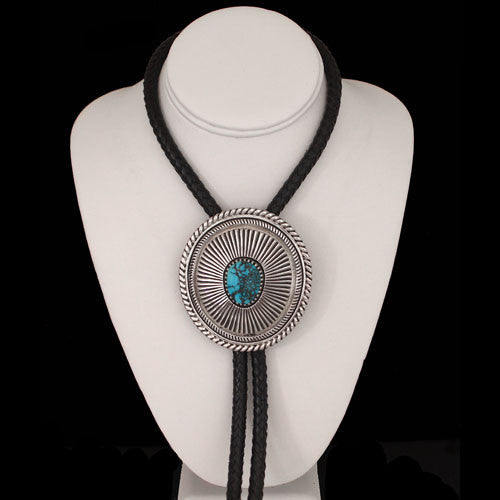
Navajo Pilot Mountain Turquoise 22.15 ct Bolo Tie - Allison Lee (#177)
$3,500.00
Artist: Allison Lee
Navajo Jewelry
Bolo: 2 3/4" x 3"
Strap: 46" long
Allison Lee, great stamping, exquisite execution, Pilot Mountain turquoise, sterling silver! What can we say? Oh yea, great price.
We offer a 100% satisfaction guarantee on every purchase.
About the artist:

Allison Lee - Navajo Silversmith:
Speaking of the silver and gold jewelry he hand crafts, Allison Lee's captivating voice is sincere when he says, "One time my uncle told me that everything we build comes from the earth, like the silver that comes from the earth, or the turquoise that comes from the earth. That is a lot of energy. You put it together and you put your heart and mind into a piece. Then sometimes a certain piece of jewelry- I believe- it is made for a certain person. I usually have a ring, or something, that stays with me for about two or three years, until the right person comes along. And then that person buys that piece. I believe that every piece of jewelry that I make is made for somebody out there- it's made for somebody special. Whoever might be having problems, or something like that. In essence, that energy helps that person get help, by wearing pieces that we make. That is the way I look at it.
Related legends:
Silversmith Work
When and how the Navajo acquired the art of working metals is unknown but there are reasons for supposing that it was introduced among them, or at least more developed and improved upon by them, since the time they have occupied their present country?
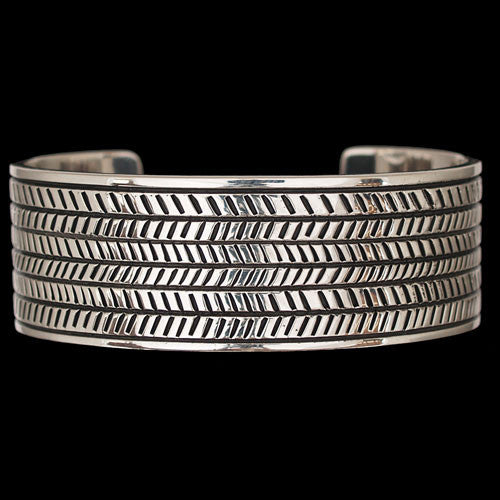
Navajo Sterling Silver Cleansing Rain Cuff Bracelet - Allison Lee (#189)
$880.00
Artist: Allison Lee
Total inner circumference including opening: 6 1/4"
Opening: 1"
Lately Allison Lee has been using simple sterling silver and elaborate stamping to create bracelets that are wearable every day, for the rest of your life. Using a simple but elegant hatching pattern to represent cleansing rain and highly polished metal, Allison has forged a superb cuff. Once you put it on, you will not want to take it off.
About the artist:

Allison Lee - Navajo Silversmith:
Speaking of the silver and gold jewelry he hand crafts, Allison Lee's captivating voice is sincere when he says, "One time my uncle told me that everything we build comes from the earth, like the silver that comes from the earth, or the turquoise that comes from the earth. That is a lot of energy. You put it together and you put your heart and mind into a piece. Then sometimes a certain piece of jewelry- I believe- it is made for a certain person. I usually have a ring, or something, that stays with me for about two or three years, until the right person comes along. And then that person buys that piece. I believe that every piece of jewelry that I make is made for somebody out there- it's made for somebody special. Whoever might be having problems, or something like that. In essence, that energy helps that person get help, by wearing pieces that we make. That is the way I look at it.
Related legends:
Silversmith Work
When and how the Navajo acquired the art of working metals is unknown but there are reasons for supposing that it was introduced among them, or at least more developed and improved upon by them, since the time they have occupied their present country?

Navajo Sterling Silver Handmade Weaving Bracelet - Allison Lee (#186)
$600.00
Artist: Allison Lee
Total inner circumference including opening: 7 1/4"
Opening: 1 1/4"
Allison Lee has handmade a work of sterling silver art. He has such handmade precision in his meticulous silver stamping, that you’d swear a computer did it. He has chosen to put a weaving design into this particular bracelet. It reminds us of the personal friend and family relationships we hold dear to our hearts. That it’s important to keep them close to us, and tightly woven together so that they can stay strong. Getting this wonderful bracelet will remind you of that every time you wear it.
About the artist:

Allison Lee - Navajo Silversmith:
Speaking of the silver and gold jewelry he hand crafts, Allison Lee's captivating voice is sincere when he says, "One time my uncle told me that everything we build comes from the earth, like the silver that comes from the earth, or the turquoise that comes from the earth. That is a lot of energy. You put it together and you put your heart and mind into a piece. Then sometimes a certain piece of jewelry- I believe- it is made for a certain person. I usually have a ring, or something, that stays with me for about two or three years, until the right person comes along. And then that person buys that piece. I believe that every piece of jewelry that I make is made for somebody out there- it's made for somebody special. Whoever might be having problems, or something like that. In essence, that energy helps that person get help, by wearing pieces that we make. That is the way I look at it.
Related legends:
Silversmith Work
When and how the Navajo acquired the art of working metals is unknown but there are reasons for supposing that it was introduced among them, or at least more developed and improved upon by them, since the time they have occupied their present country?
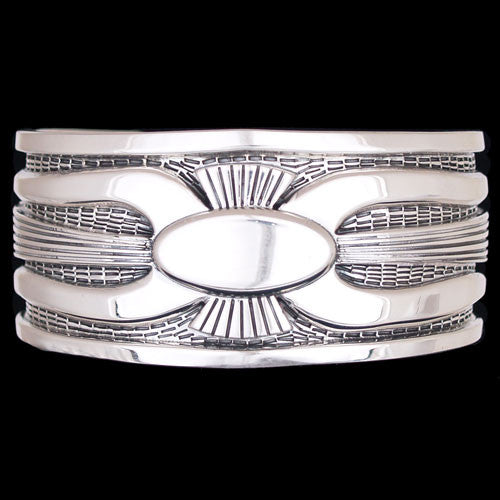
Navajo Sterling Silver Ketoh "Bow Guard" Design Bracelet - Allison Lee (#176)
$1,250.00
Artist: Allison Lee
Navajo Jewelry
Inner Cumference: 5 1/4"
Opening: 1"
Total: 6 1/4"
The ketoh or bow guard design is one of the classic motifs of Navajo art. Master craftsman Allison Lee has taken his inspiration for that tradition and made a bracelet of stunning simplicity and beauty. That, however, is par for the course with Allison.
We offer a 100% satisfaction guarantee on every purchase.

Navajo Sterling Silver Ketoh Design Buckle - Allison Lee (#192)
$880.00
Artist: Allison Lee
2 3/4" x 2"
Classic designs are Allison Lee’s specialty. With that in mind, Allison has created this amazing ketoh motif buckle. Originating with the bow guards worn by Navajo men, this design has become a classic in Southwest art. This buckle is nothing short of beautiful. You will want to wear it every day.
About the artist:

Allison Lee - Navajo Silversmith:
Speaking of the silver and gold jewelry he hand crafts, Allison Lee's captivating voice is sincere when he says, "One time my uncle told me that everything we build comes from the earth, like the silver that comes from the earth, or the turquoise that comes from the earth. That is a lot of energy. You put it together and you put your heart and mind into a piece. Then sometimes a certain piece of jewelry- I believe- it is made for a certain person. I usually have a ring, or something, that stays with me for about two or three years, until the right person comes along. And then that person buys that piece. I believe that every piece of jewelry that I make is made for somebody out there- it's made for somebody special. Whoever might be having problems, or something like that. In essence, that energy helps that person get help, by wearing pieces that we make. That is the way I look at it.
Related legends:
Silversmith Work
When and how the Navajo acquired the art of working metals is unknown but there are reasons for supposing that it was introduced among them, or at least more developed and improved upon by them, since the time they have occupied their present country?

Navajo Sterling Silver Lightning Arrow Bracelet - Allison Lee (#188)
$880.00
Artist: Allison Lee
Total inner circumference including opening: 7"
Opening: 1 1/4"
To reinforce the ideal that the Bearer of the Sun has an arsenal of incredibly powerful weapons, Allison Snowhawk Lee has crafted a bracelet depicting a most dramatic lightning arrow. Only the most powerful deities harness the greatest forces of the natural world. Only Allison has this unique way of presenting the myth and legend of his people through metal art.
About the artist:

Allison Lee - Navajo Silversmith:
Speaking of the silver and gold jewelry he hand crafts, Allison Lee's captivating voice is sincere when he says, "One time my uncle told me that everything we build comes from the earth, like the silver that comes from the earth, or the turquoise that comes from the earth. That is a lot of energy. You put it together and you put your heart and mind into a piece. Then sometimes a certain piece of jewelry- I believe- it is made for a certain person. I usually have a ring, or something, that stays with me for about two or three years, until the right person comes along. And then that person buys that piece. I believe that every piece of jewelry that I make is made for somebody out there- it's made for somebody special. Whoever might be having problems, or something like that. In essence, that energy helps that person get help, by wearing pieces that we make. That is the way I look at it.
Related legends:
Arrows
To the Navajo, flint is a sacred stone. Arrowheads are said to resemble the tips of the fiery bolt thrown by Thunder. Arrows equal lightning and some of the old warrior tales tell of mortals who wear flint armor and look like Gila Monster. In other legends, when Elder Brother sings flint songs, his voice jingles with the sound of blue flint, thunder flint, water flint, talking flint?

Navajo Sterling Silver Plain Bead Bracelet - Allison Lee (#179)
$468.00
Artist: Allison Lee
Navajo Jewelry
Inner Circumference: 6 1/4"
Opening: 1 1/2"
Total: 7 3/4"
When it comes to Southwest jewelry, men almost always get left out. Although we work hard to find good stuff for our male counterparts, there just is never enough. That is the reason Allison Lee has designed this precisely simple bracelet for us. Elegant, uncluttered and easily wearable every day, this is the cuff we have all been looking for.
We offer a 100% satisfaction guarantee on every purchase.
About the artist:

Allison Lee - Navajo Silversmith:
Speaking of the silver and gold jewelry he hand crafts, Allison Lee's captivating voice is sincere when he says, "One time my uncle told me that everything we build comes from the earth, like the silver that comes from the earth, or the turquoise that comes from the earth. That is a lot of energy. You put it together and you put your heart and mind into a piece. Then sometimes a certain piece of jewelry- I believe- it is made for a certain person. I usually have a ring, or something, that stays with me for about two or three years, until the right person comes along. And then that person buys that piece. I believe that every piece of jewelry that I make is made for somebody out there- it's made for somebody special. Whoever might be having problems, or something like that. In essence, that energy helps that person get help, by wearing pieces that we make. That is the way I look at it.
See full biography
Related legends:
Silversmith Work
When and how the Navajo acquired the art of working metals is unknown but there are reasons for supposing that it was introduced among them, or at least more developed and improved upon by them, since the time they have occupied their present country?

Navajo Tyrone Turquoise Buckle - Allison Lee (#163)
$2,400.00
Artist: Allison Lee
ATC
Navajo Jewelry
3" x 2"
Oh, Allison Lee the silversmith, who never, never, never disappoints. His work is so classically clean it makes you weep. Using a 24.3 carat piece of Tyrone turquoise and his hallmark stamping, Allison has hammered out a buckle that would make anyone shine.
We offer a 100% satisfaction guarantee on every purchase.
Tyrone Turquoise
The Tyrone turquoise mining district is made up of a small cluster of mines in the Burro Mountains near Silver City, New Mexico. This group of mines is associated with the Tyrone Copper mine owned by Phelps-Dodge. Many turquoise historians believe that more high-grade, natural turquoise was produced in this area than any single American turquoise deposit on record. Turquoise mining in the Burro Mountains has been traced back to prehistoric times. Spanish colonists mined the workings in their own time. Mining artifacts such as stone and metal tools along with fragments of turquoise mined in this fashion were common at the sites.
An early mining engineer, named Zalenski, who visiting the mines in 1907, witnessed traces the "fire-fracture" process of extracting turquoise from the host rock. Zalenski also documented one forty-foot shaft though most of the workings. The main mining process was by way of following a vein through open trenching. Early miners and archivists mention ancient and historical Indian burial grounds in the area. The graves, most often, contained offerings of turquoise. These early excavations helped to determine the locations of some of the more modern claims. According to Pogue, John Coleman aka; "Turquois John" is credited with discovering the first modern mine in the area. While on a hunting trip in 1875, John, along with W.J. Foley and Nicholas Ransome of Silver City, are credited with discovering old excavations. The men were following up on a tip from local Indian traders. Turquoise was presumed present near the town and ancient workings were known to exist in the mountains. Their search of the Burro Mountains and surrounding area proved the rumors to be true.
The largest and most recognized mine of the Tyrone workings was the Azure. The Azure mine was initiated in 1891 and was located 10 miles southwest of Silver City. Pogue states in his 1915 classic; Turquoise, Memoirs of the National Academy of Sciences, wrote; "It has been operated in modern times more extensively than any other turquois mine in this country, and its stones are the equal of the Persian gems.” In 1893 the “Elizabeth Pocket” was discovered, which produced more high-grade turquoise than any single deposit on record. The Elizabeth Pocket was 100 feet long, 40 feet wide, and 40 to 50 feet deep. At the time it was believed to be the riches vein of turquoise ever discovered. Cabochons produced from this mine were marketed throughout the country with ads appearing in Harper and McClure’s magazines. Each gem was engraved with a circle on the back with the ad stating, "None genuine without the ring O on the reverse side.” Because of its extremely hard and durable nature Azure turquoise was guaranteed not to change color. Tyrone turquoise available on today's market is mostly from older collections. In its high-grade form Tyrone turquoise is a hard, translucent, brilliant or deep blue and is highly valued by collectors for it beauty and rarity.
About the artist:

Allison Lee - Navajo Silversmith:
Speaking of the silver and gold jewelry he hand crafts, Allison Lee's captivating voice is sincere when he says, "One time my uncle told me that everything we build comes from the earth, like the silver that comes from the earth, or the turquoise that comes from the earth. That is a lot of energy. You put it together and you put your heart and mind into a piece. Then sometimes a certain piece of jewelry- I believe- it is made for a certain person. I usually have a ring, or something, that stays with me for about two or three years, until the right person comes along. And then that person buys that piece. I believe that every piece of jewelry that I make is made for somebody out there- it's made for somebody special. Whoever might be having problems, or something like that. In essence, that energy helps that person get help, by wearing pieces that we make. That is the way I look at it.
Related legends:
Precious Stones
Turquoise; Precious stones have symbolic implications. For example, turquoise if a "collective term for all the precious stones, wealth, or mixed offerings. Good fortune is attributed to this stone." Both white shell and turquoise are emphasized in Kinaalda? More about this legend
Silversmith Work
When and how the Navajo acquired the art of working metals is unknown but there are reasons for supposing that it was introduced among them, or at least more developed and improved upon by them, since the time they have occupied their present country?
